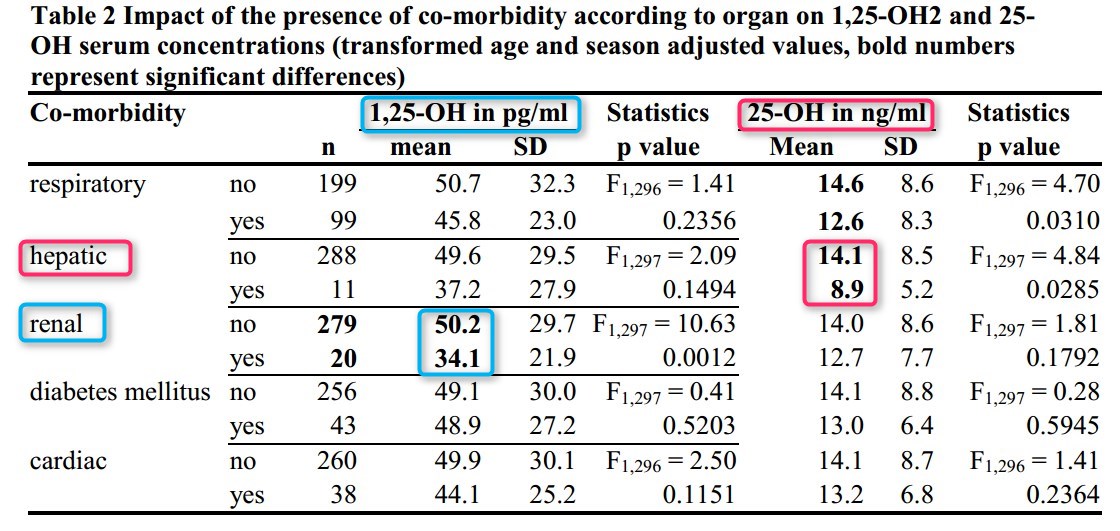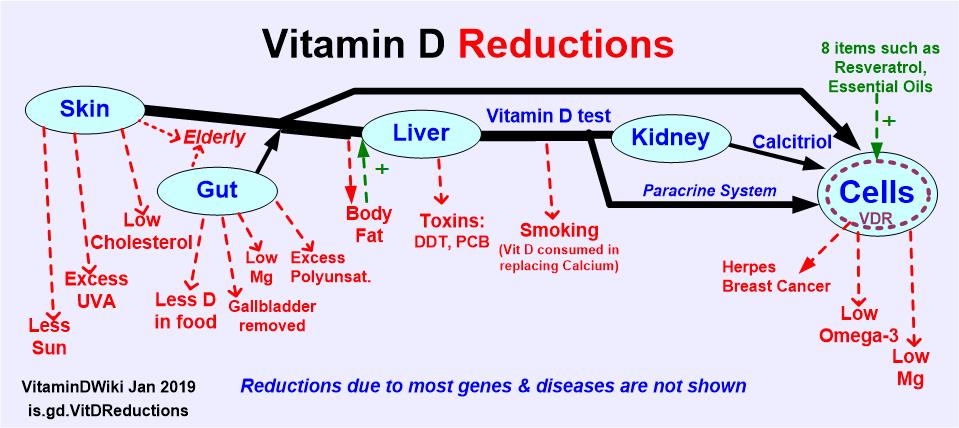Less Pneumonia in those having more activated vitamin D (kidneys working)
Vitamin D deficiency in community-acquired pneumonia: low levels of 1,25(OH)2 D are associated with disease severity
Respiratory Research 2014, 15:53 doi:10.1186/1465-9921-15-53
Mathias W Pletz, Christoph Terkamp, Ulrike Schumacher, Gernot Rohde, Hartwig Schütte, Tobias Welte and Robert Bals
Objectives
We aimed to explore the association between vitamin D levels and the severity, mortality and microbiological etiology of community-acquired pneumonia.
Methods
Vitamin D levels (both, the reservoir form 25-OH and the activated form 1,25-OH2) of 300 randomly selected patients with community-acquired pneumonia due to pre-specified pathogens included in the German competence network (CAPNETZ) study were measured. Prior to statistical analysis, values of 25-OH and 1,25-OH2 were power-transformed to achieve parametric distribution. All further analyses were performed with seasonally and age adjusted values.
Results
There was only a modest (Spearman Coefficient 0.38) positive correlation between 25-OH and 1,25-OH2. For 1,25-OH2 but not 25-OH, the general linear model revealed a significant inverse correlation between serum concentration and CURB score (p = 0.011). Liver and respiratory co-morbidity were associated with significantly lower 25-OH values and renal co-morbidity with significantly lower 1,25-OH2 values. No significant differences of 1,25-OH2 or 25-OH between different pathogens (influenza virus, Legionella spp., Streptococcus pneumoniae) were detected.
Conclusion
For 1,25-OH2, we found a significant and independent (controlled for age, season and pathogen) negative correlation to pneumonia severity. Therefore, supplementation of non-activated vitamin D to protect from pneumonia may be non-sufficient in patients that have a decreased capacity to hydroxylate 25-OH to 1,25-OH2.
From the PDF- which is attached at the bottom of this page
- “After seasonal adjustment, age had a significant impact on 1,25-OH2 levels (F1,297= 6.06, p = 0.0144) but not on 25-OH levels (F1,297= 0.03, p = 0.8588).”
- VitaminDWiki interpretation: Seniors have kidney problems, thus reducing the activation of vitamin D
Wide variance in the association between activated and typically measure serum level of vitamin D
As much as 50% variation in activated levels between individuals with the same serum level

Interesting: Liver problems reduced serum level, and somewhat reduced the activated level
Kidney problems did, as expected, reduce the activated level without reducing the serum level much

Interesting differences in vitamin D types vs types of Influenza
||Influenza type| 25-OH| 1,25-OH2
Influenza A|11 ng|64
Influenza B|13 ng|31||
VitaminDWiki speculation: Influenza B degrades the Kidney function.
See also VitaminDWiki
Search VitaminDWiki for INFLUENZA 2150 hits as of April 2014
Search VitaminDWiki for pneumonia 508 hits as of June 2017
Pneumonia in seniors was 2.5X more likely if low vitamin D – June 2014
What blocks vitamin D from getting to cells - in addition to genes and diseases has the following chart

Overview Kidney and vitamin D contains the following summary
{include}
